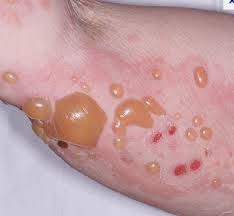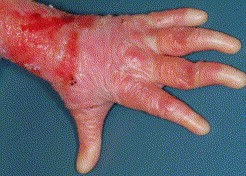What's in this article?
- 1 What Is Epidermolysis Bullosa?
- 2 Symptoms of Epidermolysis Bullosa
- 3 Who Gets Epidermolysis Bullosa?
- 4 What Causes Epidermolysis Bullosa?
- 5 How Is Epidermolysis Bullosa Diagnosed?
- 6 What Are the Symptoms of Epidermolysis Bullosa?
- 7 How Is Epidemolysis Bullosa Treated?
- 8 Signs of Infection
- 9 Treating Infection
What Is Epidermolysis Bullosa?
Epidermolysis Bullosa (EB) is an illness that causes the skin to be fragile. Because the skin is so fragile, it can be easily injured, causing painful blisters to form. These blisters can cause serious problems if they become infected.
Some people with EB have a mild form of the disease with few blisters. For others, there may be many blisters on the skin. Some people develop blisters inside the body in places such as the mouth, stomach, esophagus (the tube that allows food to move between the throat and stomach), bladder, and elsewhere.
Most types of epidermolysis bullosa initially affect infants and young children, although some people with mild forms of the condition don’t develop signs and symptoms until adolescence or early adulthood. Mild forms of epidermolysis bullosa may improve with age, but severe forms may cause serious complications and can be fatal.
There’s currently no cure for epidermolysis bullosa. For now, treatment focuses on addressing the symptoms, including pain prevention, wound prevention, infection and severe itching that occurs with continuous wound healing.
Symptoms of Epidermolysis Bullosa
The primary indication of epidermolysis bullosa is the eruption of fluid-filled blisters (bullae) on the skin, most commonly on the hands and feet in response to friction. Blisters of epidermolysis bullosa typically develop in various areas, depending on the type. In mild cases, blisters heal without scarring.
Signs and symptoms of epidermolysis bullosa may include:
- Blistering of your skin : how widespread and severe depends on the type
- Deformity or loss of fingernails and toenails
- Internal blistering, including on the throat, esophagus, upper airway, stomach, intestines and urinary tract
- Skin thickening on palms and soles of the feet (hyperkeratosis)
- Scalp blistering, scarring and hair loss (scarring alopecia)
- Thin-appearing skin (atrophic scarring)
- Tiny white skin bumps or pimples (milia)
- Dental abnormalities, such as tooth decay from poorly formed tooth enamel
- Excessive sweating
- Difficulty swallowing (dysphagia)
Who Gets Epidermolysis Bullosa?
- Anyone can have EB. Generally, the symptoms first appear in babies or toddlers.
What Causes Epidermolysis Bullosa?
- Most cases of EB are hereditary (runs in families).
How Is Epidermolysis Bullosa Diagnosed?
- A doctor can identify EB by taking a small sample of skin and looking at it under a microscope.
What Are the Symptoms of Epidermolysis Bullosa?
- Skin blisters are the major symptom of EB.
How Is Epidemolysis Bullosa Treated?
- If you, your child, or another relative has EB, coping with the symptoms can be difficult. You do not have to handle EB alone. There are doctors, nurses, social workers, clergy members, psychologists, dietitians (people who study food and nutrition), and patient and parent support groups that can help.
Signs of Infection
Even when blisters are treated properly, infections may develop. Signs of infection are:
- Redness and heat around an open area of skin
- Pus or a yellow discharge
- Crusting on the wound surface
- A red line or streak under the skin that spreads away from the blistered area
- A wound that does not heal
- Fever or chills.
Treating Infection
If you get an infection, your doctor may treat it with:
- A soaking solution
- An antibiotic ointment
- An oral antibiotic to reduce the growth of bacteria
- A special wound covering (for sores that don’t heal).









